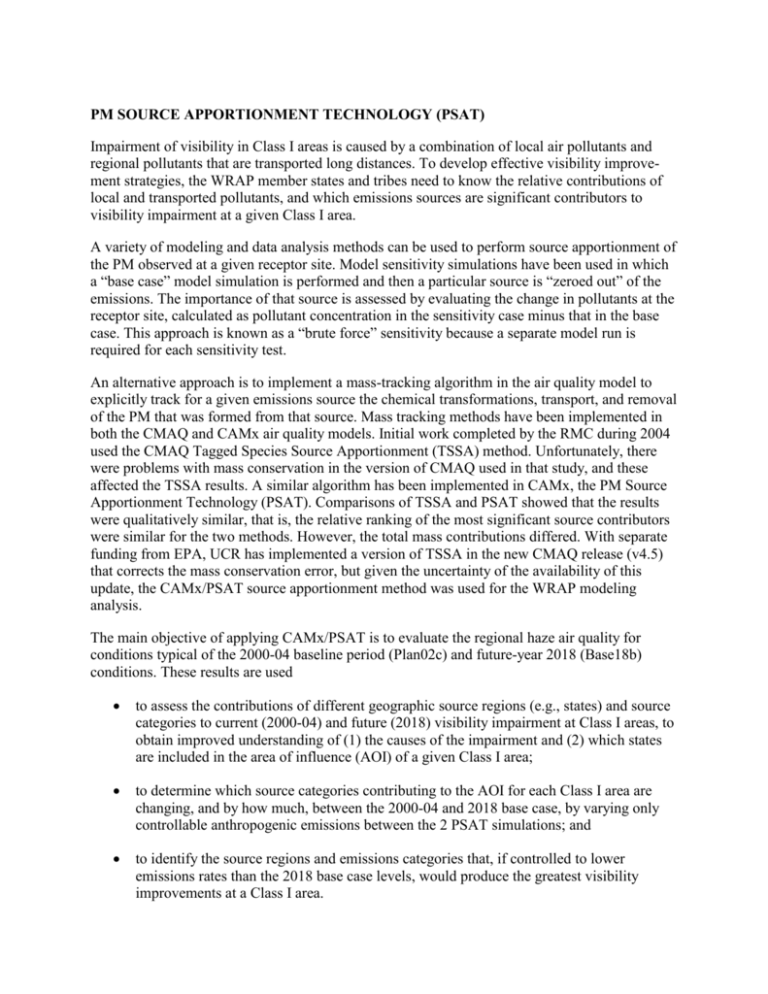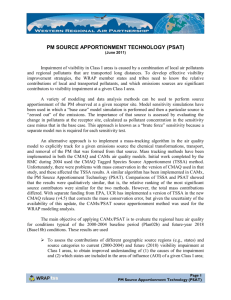PSATMethods
advertisement

PM SOURCE APPORTIONMENT TECHNOLOGY (PSAT) Impairment of visibility in Class I areas is caused by a combination of local air pollutants and regional pollutants that are transported long distances. To develop effective visibility improvement strategies, the WRAP member states and tribes need to know the relative contributions of local and transported pollutants, and which emissions sources are significant contributors to visibility impairment at a given Class I area. A variety of modeling and data analysis methods can be used to perform source apportionment of the PM observed at a given receptor site. Model sensitivity simulations have been used in which a “base case” model simulation is performed and then a particular source is “zeroed out” of the emissions. The importance of that source is assessed by evaluating the change in pollutants at the receptor site, calculated as pollutant concentration in the sensitivity case minus that in the base case. This approach is known as a “brute force” sensitivity because a separate model run is required for each sensitivity test. An alternative approach is to implement a mass-tracking algorithm in the air quality model to explicitly track for a given emissions source the chemical transformations, transport, and removal of the PM that was formed from that source. Mass tracking methods have been implemented in both the CMAQ and CAMx air quality models. Initial work completed by the RMC during 2004 used the CMAQ Tagged Species Source Apportionment (TSSA) method. Unfortunately, there were problems with mass conservation in the version of CMAQ used in that study, and these affected the TSSA results. A similar algorithm has been implemented in CAMx, the PM Source Apportionment Technology (PSAT). Comparisons of TSSA and PSAT showed that the results were qualitatively similar, that is, the relative ranking of the most significant source contributors were similar for the two methods. However, the total mass contributions differed. With separate funding from EPA, UCR has implemented a version of TSSA in the new CMAQ release (v4.5) that corrects the mass conservation error, but given the uncertainty of the availability of this update, the CAMx/PSAT source apportionment method was used for the WRAP modeling analysis. The main objective of applying CAMx/PSAT is to evaluate the regional haze air quality for conditions typical of the 2000-04 baseline period (Plan02c) and future-year 2018 (Base18b) conditions. These results are used to assess the contributions of different geographic source regions (e.g., states) and source categories to current (2000-04) and future (2018) visibility impairment at Class I areas, to obtain improved understanding of (1) the causes of the impairment and (2) which states are included in the area of influence (AOI) of a given Class I area; to determine which source categories contributing to the AOI for each Class I area are changing, and by how much, between the 2000-04 and 2018 base case, by varying only controllable anthropogenic emissions between the 2 PSAT simulations; and to identify the source regions and emissions categories that, if controlled to lower emissions rates than the 2018 base case levels, would produce the greatest visibility improvements at a Class I area. CAMx/PSAT The PM Source Apportionment Technology performs source apportionment based on userdefined source groups. A source group is the combination of a geographic source region and an emissions source category. Examples of source regions include states, nonattainment areas, and counties. Examples of source categories include mobile sources, biogenic sources, and elevated point sources; PSAT can even focus on individual sources. The user defines a geographic source region map to specify the source regions of interest. He or she then inputs each source category as separate, gridded low-level emissions and/or elevated-point-source emissions. The model then determines each source group by overlaying the source categories on the source region map. For further information, please refer to the white paper on the features and capabilities of PSAT (http://pah.cert.ucr.edu/aqm/308/reports/PSAT_White_Paper_111405_final_draft1.pdf), with additional details available in the CAMx user’s guide (ENVIRON, 2005; http://www.camx.com). PM source apportionment modeling was performed for aerosol sulfate (SO4) and aerosol nitrate (NO3) and their related species (e.g., SO2, NO, NO2, HNO3, NH3, and NH4). The PSAT simulations include 9 tracers, 18 source regions, and 6 source groups. The computational cost for each of these species differs because additional tracers must be used to track chemical conversions of precursors to the secondary PM species SO4, NO3, NH4, and secondary organic aerosols (SOA). Table 1 summarizes the computer run time required for each species. The practical implication of this table for WRAP is that it is much more expensive to perform PSAT simulations for NO3 and especially for SOA than it is to perform simulations for other species. Table 1. Benchmarks for PSAT computational costs for each PM species. Run time is for one day (01/02/2002) on the WRAP 36-km domain. No. of Species Tracers RAM Memory Disk Storage per Day Run Time with 1 CPU SO4 2 1.6 GB 1.1 GB 4.7 h/day NO3 7 1.7 GB 2.6 GB 13.2 h/day SO4 and NO3 combined 9 1.9 GB 3.3 GB 16.8 h/day SOA 14 6.8 GB Not tested Not tested Primary PM species 6 1.5 GB 3.0 GB 10.8 h/day Species Two annual 36-km CAMx/PSAT model simulations were performed: one with the Plan02c typical-year baseline case and the other with the Base18b future-year case. It is expected that the states and tribes will use these results to assess the sources that contribute to visibility impairment at each Class I Area, and to guide the choice of emission control strategies. The RMC web site includes a full set of source apportionment spatial plots and receptor bar plots for both Plan02b and Base18b. These graphical displays of the PSAT results, as well as additional analyses of these results are available on the TSS under http://vista.cira.colostate.edu/tss/Tools/ResultsSA.aspx CAMx/PSAT Configuration for 2002 and 2018 Modeling PSAT source apportionment simulations for 2000-04 baseline period and 2018 base case were performed using CAMx v4.30. Table 2 lists overall specifications for the PSAT simulations. The domain setup was identical to the standard WRAP CMAQ modeling domain. The CAMx/PSAT run-time options are shown in Table 3. The CAMx/PSAT computational cost for one simulation day with source tracking for sulfate (SO4) and nitrate (NO3) is approximately 14.5 CPU hours with an AMD Opteron CPU. The source regions used in the PSAT simulations are shown in Figure 1 and Table 4. The six emissions source groups are described in Table 5. The development of these emissions data are described in more detail below. The annual PSAT run was divided into four seasons for modeling. The initial conditions for the first season (January 1 to March 31, 2002) came from a CENRAP annual simulation. For the other three seasons, we allowed 15 model spin-up days prior to the beginning of each season. Based on the chosen set of source regions and groups, with nine tracers, and with a minimum requirement of 87,000 point sources and a horizontal domain of 148 by 112 grid cells with 19 vertical layers, the run-time memory requirement is 1.9 GB. Total disk storage per day is approximately 3.3 GB. Although the RMC’s computation nodes are equipped with dual Opteron CPUs with 2 GB of RAM and 1 GB of swap space, the high run-time memory requirements prevented running PSAT simulations using the OpenMP shared memory multiprocessing capability implemented in CAMx. Table 2. WRAP 2002 CAMx/PSAT specifications. WRAP PSAT Specs Description Model CAMx v4.30 OS/compiler Linux, pgf90 v.6.0-5 CPU type AMD Opteron with 2 GB of RAM Source region 18 source regions; see Figure 4.1 and Table 4.4 Emissions source groups Plan02b, 6 source groups; see Table 4.5 Initial conditions From CENRAP (camx.v4.30.cenrap36.omp.2001365.inst.2) Boundary conditions 3-h BC from GEOS-Chem v2 Table 3. WRAP CAMx/PSAT run-time options. WRAP PSAT specs Description Advection solver PPM Chemistry parameters CAMx4.3.chemparam.4_CF Chemistry solver CMC Plume-in-grid Not used WRAP PSAT specs Probing tool Description PSAT Dry/wet deposition TRUE (turned on) Staggered winds TRUE (turned on) Table 4. WRAP CAMx/PSAT source regions cross-reference table. Source Region ID Source Region Description1 Source Region ID Source Region Description1 1 Arizona (AZ) 10 South Dakota (SD) 2 California (CA) 11 Utah (UT) 3 Colorado (CO) 12 Washington (WA) 4 Idaho (ID) 13 Wyoming (WY) 5 Montana (MT) 14 Pacific off-shore & Sea of Cortez (OF) 6 Nevada (NV) 15 CENRAP states (CE) 7 New Mexico (NM) 16 Eastern U.S., Gulf of Mexico, & Atlantic Ocean (EA) 8 North Dakota (ND) 17 Mexico (MX) 9 Oregon (OR) 18 Canada (CN) 1The abbreviations in parentheses are used to identify source regions in PSAT receptor bar plots. 1800 1584 1368 18 18 14 1152 12 936 5 720 8 9 4 504 10 13 288 15 72 2 6 11 -144 3 16 -360 -576 1 7 16 -792 15 -1008 -1224 14 16 -1440 17 -1656 -1872 -2088 -2736 -2412 -2088 -1764 -1440 -1116 -792 -468 -144 180 504 828 1152 1476 1800 2124 2448 Figure 1. WRAP CAMx/PSAT source region map. Table 4.4 defines the source region IDs. Table 5. WRAP CAMx/PSAT emissions source groups. Emissions Source Groups Low-level Sources Elevated Sources 1 Low-level point sources (including stationary offshore) Elevated point sources (including stationary off-shore) 2 Anthropogenic wildfires (WRAP only) Anthropogenic wild fires (WRAP only) 3 Total mobile (on-road, off-road, including planes, trains, ships in/near port, off-shore shipping) Emissions Source Groups Low-level Sources Elevated Sources 4 Natural emissions (natural fire, WRAP only, biogenics) Natural emissions (natural fire, WRAP only, biogenics) 5 Non-WRAP wildfires (elevated fire sources in other RPOs) Non-WRAP wild fires (elevated fire sources in other RPOs) 6 Everything else (area sources, all dust, fugitive ammonia, non-elevated fire sources in other RPOs) Preparation of Emissions Data Emissions datasets for the CAMx/PSAT simulations were prepared directly from the SMOKEprocessed emissions developed for CMAQ. A simple format conversion was used to convert the original SMOKE output files from the I/O API format to the CAMx format. For certain source categories, SMOKE was configured to output CAMx-formatted files directly. In addition, CMAQ species names were changed for several of the emissions species to make them consistent with the CAMx species. Additional processing was also required for the PSAT algorithm. For each of the emissions categories that were tracked in PSAT, the intermediate SMOKE output files for those categories were converted to the CAMx/PSAT formats, and read by the CAMx program to distinguish among the emissions source categories. The elevated-point-source CAMx emissions files were also processed files to specify the PSAT source region individually for each point source. This was necessary in order to assign elevated-point-source emissions to the correct PSAT source region (particularly near state boundaries and along coastal regions), due to the relatively coarse (36-km) grid cell resolution. No additional post-processing QA was performed on the CAMx emissions files, since they were prepared directly from the previously quality-assured CMAQ emissions files. However, the CAMx/PSAT simulations by comparing the CAMx- and CMAQ-predicted species concentrations as part of the overall QA of the model simulations.









